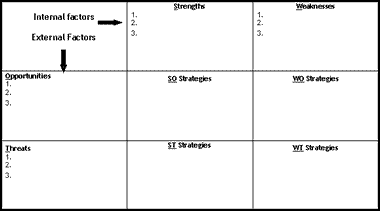 |
|
Five Guidelines for Making Your SWOT Hummm…
By Zuhair Suidan
A mainstay in strategic planning is SWOT analysis, which is analysis of internal Strengths and Weaknesses, and external Opportunities and Threats. While frequently done, this activity is often poorly applied and the resulting under-utilization of the SWOT analysis potential has given the process a lackluster name with some who have used it.
Here are five guidelines for maximizing the yield from your SWOT analysis.
- SWOT analysis can be applied at different levels. It provides insight at a corporate level, at business unit level, at a market level, at a segment level, at a product line level, as well as at an individual product offering level. You need to understand the level at which you are conducting the analysis to assure consistency, integrity and thoroughness of your analysis.
For example doing SWOT analysis by segment will give you far greater granularity and ‘actionability’ than doing it merely at a market level, since you are likely to have different strengths, weaknesses, opportunities and threats in different segments. A market level analysis, while still useful, ‘averages’ these more nuanced and varied views, and can mask the insights they provide.
- SWOT analyses often generate long laundry lists in each of the 4 SWOT categories. While long lists generated by brainstorming are a useful (and recommended) first step, they often result in items of marginal significance, as well as items that can be aggregated. It is important then to prioritize and aggregate the SWOT items and narrow the thinking to the most significant ones. I encourage teams to focus on the ‘Top three’ Strengths, Weaknesses, Opportunities and Threats. While the 3 is not cast in stone, 2 to 5 is a good range to aim for, if you wind up with the right ones. The right top 3 in any category probably cover the majority of significance in that category, and that’s a good start.
- It is best if SWOT analysis is done by a representative cross-functional team (e.g. sales, marketing, communications, development, finance…), and one with an intimate knowledge of the market and its needs. Such a team will likely produce better analysis and the results will have a broader, company-wide built-in buy-in.
- Teams listing the SWOT feel a sense of accomplishment and often stop there. If so, that’s a crying shame. It is also the prime reason why SWOT analysis has a lackluster name with some who have gone through it. Listing the Strengths, Weakness, Opportunities and Threats is an important analysis step. But if you stop there you are forfeiting the benefit that SWOT enables in strategic planning. To get this benefit, you need to ‘marry’ your internal Strengths and Weaknesses to your external Opportunities and Threats. To do this, map your SWOT using the following template:

Completing the four bottom right cells in the chart is the yield from your analysis – the strategy component. It answers how you plan to leverage your strengths to take advantage of your opportunities and avoid your threats. It also answers how you plan to overcome your weaknesses so they don’t get in the way of your opportunities or enable your threats. So, in the SO Strategies cell, list the Strategies that use strengths to take advantage of opportunities; in the ST Strategies cell, the Strategies that use strengths to avoid, contain and manage threats; in the WO Strategies cell, list the Strategies that take advantage of opportunities by overcoming weaknesses, and finally in the WT Strategies cell, the Strategies that minimize weaknesses and avoid threats.
- While completing the four bottom-right cells of the chart above, make sure that every strength is matched to an opportunity and / or a threat. The same on the weaknesses. Likewise check to see that every opportunity and threat leverages a strength and / or circumvents a weakness. For example, if you find some unmatched strengths, you need to go back to your strategy and see whether these strengths are costing you more than they are worth. You may be better off investing in developing other strengths instead, ones which can be more readily leveraged for capitalizing on your opportunities and addressing your threats.
Done right, SWOT analysis can regain its role as a cornerstone of strategic planning.
|



